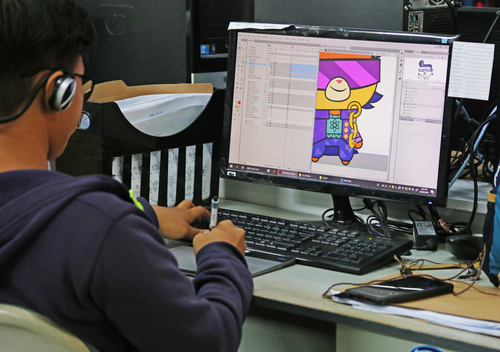 Did you grow up loving Saturday Morning Cartoons on TV, or were you born this century? Because these days, most animation is online. But although where, when, and how we watch animation has changed over the decades, animation remains everywhere: From streaming animated shows to computer animation and motion graphics across a broad range of media, and including advertising and web design. That’s even true in the realms of science and technology.
Did you grow up loving Saturday Morning Cartoons on TV, or were you born this century? Because these days, most animation is online. But although where, when, and how we watch animation has changed over the decades, animation remains everywhere: From streaming animated shows to computer animation and motion graphics across a broad range of media, and including advertising and web design. That’s even true in the realms of science and technology.
For this reason, expertise in skills like 3D modeling are highly in demand. For anyone interested in finding creative and rewarding work as an animator, combining a natural talent for art and design with a degree in animation is a great place to start.
In this guide, we’ll tell you what you need to know about earning your degree in the exciting field of animation, as well as a bit about only a few of the exciting careers made possible when you study animation in college.
What Is Animation
Were you the kind of kid that was always doodling on paper, experimenting with digital art, or dreaming up characters and stories of your own? This could mean a future in animation is right for you. Here are some other traits common to those successful in motion graphics, digital art, or in animated movies and television series:
- Creativity
- Visual orientation
- Problem solving skills
- Organization and time-management skills
Does this sound like you? You’re already well on your way to working in Hollywood or in web design. What might be missing is your college degree.
But what kind of animation is right for you? Because there’s more than just one kind of animation, and students have different areas of emphasis while studying animation in school. Here are some examples:
- Fine art. Animation programs taking a fine arts approach teach classical animation, including color design, movement, and composition, among other principles.
- Modeling. Emphasizing 3D modeling of characters, textures, and surfaces, an animation degree concentrated in modeling will prepare a graduate to work in CGI, video games, and movie and television special effects.
- Computer animation. Rather than strictly a classical education in art and animation, computer animation will prepare a graduate to work with state-of-the-art technology and software.
- Special effects. From zooming spaceships to monsters and other denizens of your imagination come to life, the ability to produce breathtaking and realistic special effects is at the heart of the film and television industry, and increasingly in demand on the internet as well.
No matter what area of emphasis is right for you, many fundamental principles and skills will remain the same. That’s in addition to the core educational requirements common to any college degree.
Graduate from any animation program, in fact, either online, in-person, or through a hybrid model, and you can count on being well-grounded in the following:
- Cartooning styles
- Color and composition
- Drawing skills
- Filmmaking
- Storyboarding
- Motion capture and how to use it
- The history of animation
- Animation software
And the list goes on …
Assume an animation degree will only lead to work making children’s movies? Think again. We’ll tell you about just a few of the exciting careers made possible by a degree in animation in our next section.
Careers in Animation
 In addition to what’s listed below, many who study drawing or 3D modeling in college go on to work as graphic designers, multimedia artists, or as an art director in all different kinds of media. In this section we present a closer look at a few more careers waiting for you on the other end of that animation degree.
In addition to what’s listed below, many who study drawing or 3D modeling in college go on to work as graphic designers, multimedia artists, or as an art director in all different kinds of media. In this section we present a closer look at a few more careers waiting for you on the other end of that animation degree.
| Job Title | Approx. # Years of Education | Average Annual Salary |
| Special Effects Artists and Animators | 4 | $77,700 |
| Web Developers and Digital Designers | 4 | $77,200 |
| Producers and Directors | 4 | $76,400 |
| Software Developers | 4 | $110,140 |
| Craft and Fine Artists | 4 | $49,120 |
Special Effects Artists and Animators
Perhaps naturally, many seek a degree in animation to become a special effects artist or animator, whether their work ends up in Hollywood, on TV, online, or in any number of emerging platforms like mobile apps.
In their work, special effects artists and animators create images, characters, and graphics that appear to move or to tell a story. Working alone or sometimes in a team, experts in this area carefully research their projects to produce works as realistically as possible, integrating and balancing feedback and input from the team, from directors and producers, game designers, and clients.
Those who work in this field tend to have a specialty, including movie and TV programs, computer generated imagery, or CGI. Some focus on character development and realistic motion, while others produce digital backgrounds and textures. And although these days, much of this work is done digitally, many continue to animate using classical techniques such as drawing and painting.
So, in addition to technical know-how, artistic talent, creativity, time management skills, and strong communication skills are all important traits for those successful in this industry.
According to the Bureau of Labor Statistics, special effects artists and animators make about $78,000 a year, and a bachelor’s degree in animation or a related major along with a strong portfolio of work are most often the minimum education requirement to get into the business.
Also according to the BLS, the already strong job outlook for special effects artists and animators is expected to grow at a rate 4% in the decade spanning 2019 through 2029, which is an average rate of growth for many other professions.
Most professionals in this line of work are self-employed, according to the BLS. Following that, 14% find work in the motion picture and video industries, with an additional 7% working for software publishers. The remaining 5% of all special effects artists and animators pursue computer systems design, and the final 3% are employed in advertising, public relations, and related services.
Good areas to live in for special effects artists and animators include California and New York.
Web Developers and Digital Designers
 Another common career path for those who graduate with degrees in animation is to become a web developer or digital designer. This work can include everything from web design and app user interfaces to a broad range of other digital applications, and many of these applications are just emerging in the ever-changing world of the internet.
Another common career path for those who graduate with degrees in animation is to become a web developer or digital designer. This work can include everything from web design and app user interfaces to a broad range of other digital applications, and many of these applications are just emerging in the ever-changing world of the internet.
For this reason, strong computer skills are a prerequisite for this work, as web developers create and test applications, user experiences, menus, and graphical elements used on the web and in mobile applications.
The process of web development and digital design most often includes meetings with clients, management, or producers, covering areas like the usability and functionality of the interface, as well as the overall look, feel, and purpose of the project. This means integrating audio, motion graphics, video, and other elements. And most often, these projects are executed in a team environment, including other graphic artists and designers.
Most likely, web designers are also responsible for monitoring website traffic once the project is complete.
Given the heavily digital nature of the work, a strong background in programming languages like HTML and Javascript is also a prerequisite for the work, and many graduates go on to earn professional certification in these areas, such as SQL certification programs, many of which are available online.
There are also specific types of designers in this field, such as back-end developers, responsible for the “engine” of the website, front-end developers, in charge of the user experience portion of the project, and full-stack developers who can do it all.
According to the Bureau of Labor Statistics, web developers and digital designers make about $77,000 a year on average, and a bachelor’s degree in a major like animation with a strong portfolio are most often the minimum educational requirements to find work in this profession.
Also according to the BLS, work prospects for artists and designers of this sort are expected to grow at a rate of 8% in the decade between 2019 and 2029, which is a much faster rate of expansion than in many other professions. Further data from the BLS says 17% of all web developers and digital designers work in computer systems design and related services, while 10% are employed in the publishing industry.
Following those numbers, 10% of all web and digital developers are self-employed, while 5% work for technical and scientific consulting services. The remaining 4% of all web developers and digital designers work in advertising, public relations, and related industries. According to the BLS, good states to live in for those interested in finding work in these professions include California and Washington.
Producers and Directors
From film and television to online-based media, the next career step for many in the animation business is to become a producer or director. Many more, however, go straight to this work after graduating with their degree in animation.
The job of a producer and director often begins by selecting a project for film, TV, or other medium. Sometimes this process begins with only a script. For this reason, the ability to visualize the end product is an important part of the work.
Especially for producers, the job also means securing financing for every aspect of the production, overseeing the production process, sometimes including the quality of the performances, sets, lighting, and cinematography. The work doesn’t end when the production is over, as producers and directors stay involved throughout editing, music selection, and other aspects of the post-production process.
Producers and directors must also operate within the budget and production schedule, delivering a product on time and for the right price. And once complete, producers and directors often continue to promote the production in the media.
As can be seen, producers and directors have a lot of responsibility. For this reason, they’re often paid handsomely. According to the Bureau of Labor Statistics, producers and directors earn about $76,000 annually, and a bachelor’s degree is the minimum educational requirement for the job.
Also according to the BLS, it’s a good time to get into the business, as job opportunities are expected to grow at a rate of 10% in the years between 2019 and 2029, which is much faster than the average rate of growth in many other professions.
The BLS goes on to say that 28% of all producers and directors work in the motion picture and video industries. Following that number, 20% work in radio and TV, and 17% are self-employed. An additional 8% of all producers and directors work in spectator sports, the performing arts, and related industries, and 5% work in advertising, public relations, and associated industries.
States with strong employment numbers for producers and directors include California and New York.
Software Developers
 With the rise of motion graphics and other elements common to software, many skills held by animators translate well to the software development industry. In their work, software developers dream of new mobile apps and computer programs for our increasingly digital lifestyle. And as smart tech becomes more ubiquitous, these job skills have become even more in demand.
With the rise of motion graphics and other elements common to software, many skills held by animators translate well to the software development industry. In their work, software developers dream of new mobile apps and computer programs for our increasingly digital lifestyle. And as smart tech becomes more ubiquitous, these job skills have become even more in demand.
Software developers often work with clients seeking to satisfy a specific need with a new piece of software, or to bring a software or service to market. For these reasons, software developers must carefully gather information about what problem the software should address or the solution the application should provide to the end user.
This can include a lengthy, highly-collaborative, and intensive design, testing, and development process with many revisions and updates along the way.
Also part of the job of a software developer is the ability to see how all the moving parts of the software will work together, which can include a visualization and planning process with flowcharts, diagrams, and graphs, keeping the software development team on the same page and communicating the progress to the client.
And once the software process is complete, software developers must continue to monitor functionality through testing and maintenance, documenting this step carefully for future upgrades and general upkeep. Software developers often work within a team, but also sometimes in a supervisory role.
This is a lot of responsibility, and software developers are paid accordingly. According to the Bureau of Labor Statistics, in fact, software developers make about $110,000 a year. Furthermore, the already strong market for software developers is expected to explode in the decade between 2019 and 2029 at a rate of 22%, nearly 4-times the average rate of growth in many other industries.
Also according to the BLS, 33% of all software developers work in computer systems design and related industries, while 11% work in manufacturing. An additional 9% work in software publishing, and 5% work in management. Finally, 4% are employed by insurance carriers or in related services.
A bachelor’s degree is the minimum education requirement to become a software developer, often in computer science but also digital animation or related majors.
In addition to a degree, software developers also often seek professional certification in development platforms like Amazon Web Services, Microsoft Azure, or Cloudera, among many others. These certifications can be especially important for those entering the industry from outside the field of computer science, such as animation majors.
And finally, good states to live in for those interested in becoming software developers include California and Texas, according to the BLS.
Craft and Fine Artists
Animation isn’t always about doing work for others. Many pursue degrees in animation to realize their own vision as a craft or fine artist.
Though difficult industries to gain a foothold in, craft and fine artists use their skills to bring to market works developed in a variety of mediums, including drawing, painting, and animation. This can also sometimes include new and previously unknown mediums, or a blend of existing mediums such as digital and traditional art styles at the forefront of animation.
Also part of the work of a craft or fine artist is to plan their work through sketches and other preliminary templates or models. This can be especially important when working on commission. They select the material from which the work will be created, always maintaining a keen eye for composition, color, and other elements of design.
To be successful in this industry, artists of this sort must develop a strong portfolio, and show their work as often as possible, which in the case of an animator might include animation film festivals or through online platforms.
Craft or fine artists are often financially supported through grants, which often includes a lengthy and involved application and proposal process.
According to the Bureau of Labor Statistics, craft and fine artists make about $50,000 a year on average, and job prospects are expected to remain steady in the decade between 2019 and 2029.
Most artists of this sort are self-employed, according to the BLS, at 51%, and an additional 9% are classified as independent artists.
Following those numbers, 7% work for the government, 4% work in the motion picture industry, and the remaining 3% work in personal care services.
There are no real education requirements to be successful, but many study their medium of choice, such as a bachelor’s degree in animation, or even possibly an MFA or Master of Fine Arts. No matter what, a strong portfolio is crucially important for a craft or fine artist.
Depending on the kind of art in question, good states to live include California, Texas, Michigan, and Pennsylvania, according to the BLS.
Animation Degrees
 Now that you have some sense of just a few of the many great careers made possible with a degree in animation, let’s now turn our attention to the degrees through which any one of these dream jobs could become a reality.
Now that you have some sense of just a few of the many great careers made possible with a degree in animation, let’s now turn our attention to the degrees through which any one of these dream jobs could become a reality.
Associate Degree in Animation
Most often offered at community colleges, junior colleges, or at technical schools, associate degrees in animation or in an animation-related topic are a great place to start for anyone interested in getting into the industry.
Students interested in transferring credits earned in an associate degree program to complete their bachelor’s degree should pursue an Associate of Fine Arts degree offering an emphasis in animation or the opportunity to take courses in the topic.
It is possible, though, to earn an associate degree in animation from a technical school, and many affordable animation programs are offered online. Vocational in nature, these degrees help graduates enter the workforce as quickly as possible, meaning an online associate degree in animation could also be a more affordable option than a bachelor’s degree, while also helping students prepare a portfolio of work.
In any associate degree program in animation, topics typically covered include design fundamentals, drawing, color theory, and computer animation, among other topics. And graduates will most likely be proficient in relevant software, with skills in Illustrator, Quicktime, Premier and Adobe Photoshop, as well as other applications.
Whether they’re at a public community college or a private trade school, most associate degree programs consist of about 60 credit hours, which takes most students about two years to complete.
Given the highly digital nature of modern animation, it’s a particularly good choice for an online or hybrid-style program. No matter the level of degree, students pursuing an online diploma should ensure their program is recognized by the Distance Education Accrediting Commission.
A high school diploma, GED or equivalent with transcripts is a prerequisite for any associate degree program, and in the case of an animation program, some portfolio work may also be required. Many professional associate degree programs conclude with an internship, helping graduates find work as quickly as possible.
Bachelor’s Degree in Animation
Whether transferred into from an associate program, or applied to directly from high school, a bachelor’s degree in animation is the next degree option for those interested in a career in animation. Some institutions offer degrees like a Bachelor of Fine Arts (BFA) in animation, while others allow an emphasis in traditional or digital animation within their fine arts program.
Bachelor’s degrees are more expensive than an associate degree, but they can be worth it for increased networking opportunities, and the chance for students to further develop their skills while building a quality portfolio. Some save money on their degree by choosing an online animation degree program.
In addition to general education, skills taught include digital animation, typography, interactive digital media, and 3D modeling. Areas of emphasis and specialization could also include game design, character animation, and interface animation.
A high school diploma, GED, or equivalent with transcripts and a GPA of at least 2.0 is most often the minimum prerequisite for any bachelor’s degree program. Submitting SAT or ACT scores may also be required, but application requirements vary between programs. It’s also important that any program be accredited by the National Association of Schools of Art and Design (NASAD).
Following graduation, many students continue on to earn certifications, such as the Adobe Certified Associate Program, Microsoft Visual Studio Certifications, or the IEEE Software Developer Certification.
These designations are rarely required by an employer but they do set applicants apart from the competition. Otherwise, bachelor degree programs typically consist of 120 credit hours, which takes most students about four years to complete.
Master’s Degree in Animation
Stepping up from a BFA in animation, the next tier of education available is a Master of Fine Arts (MFA) in animation, or an MFA with an emphasis in an animation-related area of expertise, such as character modeling or digital animation.
Degrees of this nature are rarely required by an employer, but they could increase career advancement opportunities, or simply set a candidate apart from other applicants. An MFA in animation will, however, qualify a graduate to teach animation at the level of a college or university.
Moving on from the fundamentals taught in a bachelor’s degree program, an MFA in animation will allow a student to further hone their skill in an area of expertise, while also possibly creating crucial networking opportunities within the film, television, or marketing industries.
Among many other career opportunities, those who graduate with an MFA go on to become art directors, character artists, or multimedia specialists.
For this reason, It’s important to consider your own career goals before choosing a program. For example, some may be better suited to facilitate opportunities in Hollywood as opposed to advertising, among other industries.
All MFA programs require a thesis project to complete. A bachelor’s degree, a strong portfolio of work with transcripts, and a GPA of at least 3.0 are the minimum application requirements at most institutions. Test scores and letters of recommendation or a statement of personal intent may also be called for though this varies greatly between programs.
The average master’s degree program consists of about 40 credit hours which takes most students about two years to complete though this, too, can vary. Many students also teach at the school from which they’re earning their degree.
Doctoral Degree in Animation
Not all who study animation in college intend to work in the media industry. Many go on to research and develop new technology in animation; to study the history, theory, or to analyze the history animation; teach at the college or university level; or speak and write on the topic in a public forum.
For these reasons, some go on to earn a Ph.D. in fine arts or visual communication with an emphasis in animation. Doctoral or Ph.D. degrees specifically in animation are rare, and not typically offered in the U.S.
Visual art and design programs at the Ph.D. level with an emphasis in animation are more common overseas, however, and many students from all over the world pursue these programs to teach, research, or write on the subject of their passion.
Another option for those interested in attaining the highest level of education in the topic of animation could consider a Ph.D. in media studies, film, cinematography, or even computer science, all of which may offer areas of emphasis is animation, 3D modeling, or motion graphics.
Typically, Ph.D. programs consist of about 50 credit hours, which takes most students about two years to complete, although many students take much longer. This time is also often spent teaching at the school from which they’re earning their degree.
A master’s degree like an MFA with transcripts and a GPA of 3.5 is the minimum education requirement for any Ph.D. program, although test scores, letters of recommendation, and a statement of personal intent may also be required.
All Ph.D. programs require either the development of an original thesis project, possibly demonstrating new techniques or technology related to animation or fresh analysis or scholarship in the topic.
Related:
- Ultimate Guide to Graphic Design
- Most Affordable Online Animation Degrees
- Best Online Masters in Graphic Design





